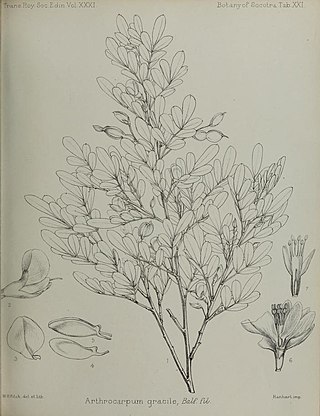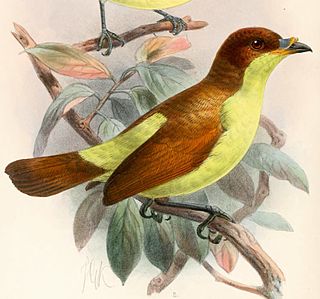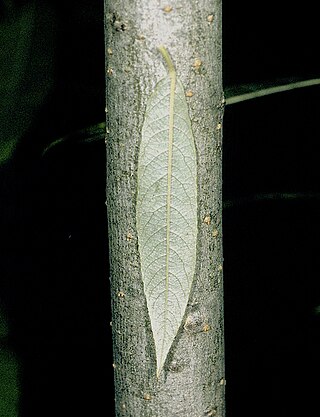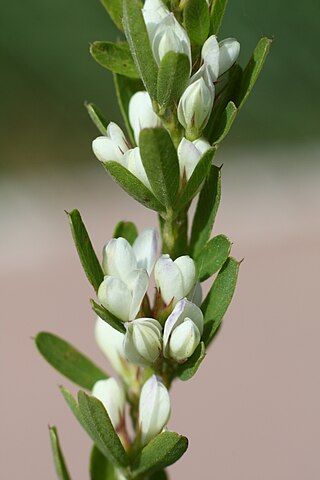
Annona sericea is a species of plant in the family Annonaceae. It is native to Bolivia, Brazil, Colombia, French Guiana, Guyana, Suriname, Trinidad-Tobago and Venezuela. Michel Félix Dunal, the French botanist who first formally described the species, named it after the silky hairs on its branches and leaves. In Brazil its common name is Aratincum do Para.

Leucosidea sericea, commonly known as oldwood, is an evergreen tree or large shrub that grows in the highland regions of southern Africa. It is the sole species in the monotypic genus Leucosidea. The name oldwood may reflect the fact that the wood burns slowly, as if old and rotting; the gnarled, twisted trunks reinforce this impression.

Chapmannia gracilis is a species of flowering plant in the family Fabaceae. It is endemic to north-central and northeastern Socotra in Yemen. Its natural habitat is subtropical or tropical dry forests.
Chapmannia reghidensis is a species of flowering plant in the family Fabaceae. It is endemic to northern Socotra in Yemen. Its natural habitat is subtropical or tropical dry forests. It is threatened by habitat loss.
Chapmannia tinireana is a species of flowering plant in the family Fabaceae. It is endemic to north-central Socotra in Yemen. Its natural habitat is subtropical or tropical dry forests. It is threatened by habitat loss.

Grevillea sericea, commonly known as the pink spider flower, is a species of flowering plant in the family Proteaceae and is endemic to New South Wales. It is a shrub with elliptic to lance-shaped leaves with the narrower end towards the base, and clusters of usually pink flowers arranged on one side of a flowering rachis.

Stephen's lorikeet, also known as the Henderson lorikeet or the Henderson Island Lorikeet, is a species of parrot in the family Psittaculidae. It is endemic to Henderson Island in the Pitcairn Islands of the South Pacific.

The yellow-breasted satinbird, formerly known as the yellow-breasted bird-of-paradise and also known as the silken satinbird, is a species of bird in the family Cnemophilidae. It is monotypic within the genus Loboparadisea. It is found in the New Guinea highlands. Its natural habitats are subtropical or tropical moist lowland forest and subtropical or tropical moist montane forest. It is threatened by habitat loss.
Breviea is a genus of plant in the family Sapotaceae described in 1935.
Calceolaria sericea is a species of plant in the Calceolariaceae family. It is endemic to Ecuador.
Glionnetia is a monotypic genus of flowering plants in the family Rubiaceae. The genus contains only one species, viz. Glionnetia sericea, which is endemic to Mahé and Silhouette Island in the Seychelles. The species thrives mainly on high ridges in the mountains and it does not seem to grow well at lower altitudes. Glionnetia sericea is a small flower with paniculate terminal inflorescences and it has capsules that are dispersed by wind.
Knema sericea is a species of plant in the family Myristicaceae. It is a tree endemic to Borneo.
Parinari argenteo-sericea is a tree of Borneo in the family Chrysobalanaceae. The specific epithet argenteo-sericea is from the Latin meaning "silvery silky", referring to the pubescence of the inflorescence and flowers.

Sanchezia sericea is a species of plant in the family Acanthaceae. It is endemic to Ecuador. Its natural habitats are subtropical or tropical moist lowland forests and subtropical or tropical moist montane forests. It is threatened by habitat loss.

Selaginella sericea is a species of plant in the Selaginellaceae family. It is endemic to Ecuador. Its natural habitat is subtropical or tropical moist lowland forest and subtropical or tropical moist montane forest. It is threatened by habitat loss.

Salix sericea, commonly known as silky willow, is a shrub in the Salicaceae family that grows in swamps and along rivers in eastern United States and Canada. It is 2 to 4 m tall and has long, thin, purplish twigs. The leaves are 6–10 cm long, 7–8 mm wide, lanceolate, acuminate, serrulate, dark green and lightly hairy on top, and light green and densely covered with white silky hairs underneath. Mature leaves are glabrous. The petioles are 1 cm long. Catkins are sessile and usually bracteate. S. sericea blooms in May and fruits in June.

Lespedeza cuneata is a species of flowering plant in the legume family known by the common names Chinese bushclover and sericea lespedeza, or just sericea. It is native to Asia and is present elsewhere as an introduced species and sometimes an invasive plant. Australian populations of Lespedeza juncea have sometimes been considered to belong to this species but are now considered to be distinct.
Madhuca sericea is a tree in the family Sapotaceae. The specific epithet sericea means 'silky', referring to the indumentum.
Dioscorea sericea is a type of climbing tuberous geophyte in the family Dioscoreaceae. It is native to Colombia and Peru.

Byrsonima sericea is a species of semi-deciduous tree native to Brazil, Bolivia, Peru, Guyana, and French Guiana.











